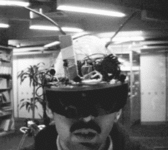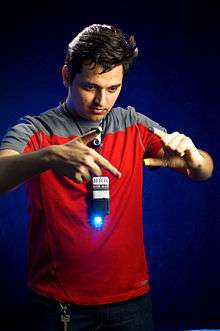SixthSense
SixthSense is a gesture-based wearable computer system developed at MIT Media Lab by Steve Mann in 1994 and 1997 (headworn gestural interface), and 1998 (neckworn version), and further developed by Pranav Mistry (also at MIT Media Lab), in 2009, both of whom developed both hardware and software for both headworn and neckworn versions of it. It comprises a headworn or neck-worn pendant that contains both a data projector and camera. Headworn versions were built at MIT Media Lab in 1997 (by Mann) that combined cameras and illumination systems for interactive photographic art, and also included gesture recognition (e.g. finger-tracking using colored tape on the fingers).[3]


SixthSense is a name for extra information supplied by a wearable computer, such as the device called EyeTap (Mann), Telepointer (Mann), and "WuW" (Wear yoUr World) by Pranav Mistry.[6][7]
Origin of the name
Sixth Sense technology (a camera combined with a light source) was developed in 1997 as a headworn device, and in 1998 as a neckworn object, but the Sixth Sense name for this work was not coined and published until 2001, when Mann coined the term "Sixth Sense" to describe such devices.[8][9]
Mann referred to this wearable computing technology as affording a "Synthetic Synesthesia of the Sixth Sense", believing that wearable computing and digital information could act in addition to the five traditional senses.[10] Ten years later, Pattie Maes, also with MIT Media Lab, used the term "Sixth Sense" in this same context, in a TED talk.
Similarly, other inventors have used the term sixth-sense technology to describe new capabilities that augment the traditional five human senses. For example, in U.S. patent no. 9,374,397, timo platt et als, refer to their new communications invention as creating a new social and personal sense, i.e., a "metaphorical sixth sense", enabling users (while retaining their privacy and anonymity) to sense and share the "stories" and other attributes and information of those around them.
References
- ↑ "Telepointer: Hands-Free Completely Self Contained Wearable Visual Augmented Reality without Headwear and without any Infrastructural Reliance", IEEE International Symposium on Wearable Computing (ISWC00), pp. 177, 2000, Los Alamitos, CA, USA
- ↑ "WUW – wear Ur world: a wearable gestural interface", Proceedings of CHI EA '09 Extended Abstracts on Human Factors in Computing Systems Pages 4111-4116, ACM New York, NY, USA
- ↑ IEEE Computer, Vol. 30, No. 2, February 1997, Wearable Computing: A First Step Toward Personal Imaging, pp25-32
- ↑ Wearable, tetherless computer–mediated reality, Steve Mann. February 1996. In Presentation at the American Association of Artificial Intelligence, 1996 Symposium; early draft appears as MIT Media Lab Technical Report 260, December 1994
- ↑ IEEE Computer, Vol. 30, No. 2, February 1997, Wearable Computing: A First Step Toward Personal Imaging, pp25-32
- ↑ "IEEE ISWC P. 177" (PDF). Retrieved 2013-10-07.
- ↑ "Cyborg: Digital Destiny and Human Possibility in the Age of the Wearable Computer", Steve Mann with Hal Niedzviecki, ISBN 0-385-65825-7 (Hardcover), Random House Inc, 304 pages, 2001.
- ↑ Cyborg, 2001
- ↑ Geary 2002
- ↑ An Anatomy of the New Bionic Senses [Hardcover], by James Geary, 2002, 214pp
Further reading
- Elish, M. C. (2011, January). Responsible storytelling: communicating research in video demos. In Proceedings of the fifth international conference on Tangible, embedded, and embodied interaction (pp. 25–28). ACM.
External links
- Sixthsense Tutorials
- Steve Mann's SixthSense site
- Pranav Mistry's SixthSense homepage
- SixthSense Google code site
- SixthSense Github repository

